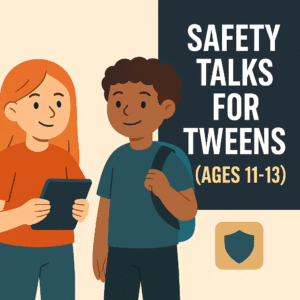How to Talk to Middle Schoolers About Safety (Ages 11–13): Building Awareness and Independence
Middle school marks a turning point in a child’s life. Between ages 11 and 13, kids are testing independence, navigating peer pressure, and spending more unsupervised time online and in the community. This stage is full of new risks and new opportunities — which makes it a critical time for parents to strengthen safety conversations.
At The Security Playbook, Coach Cover is here to guide you through trauma-informed, age-appropriate strategies for helping tweens navigate safety with confidence and resilience.
Why Safety Talks Matter in Middle School
-
More independence = more exposure. Kids may walk to school, hang out at friends’ houses, or go online unsupervised.
-
Peer influence peaks. At this age, the drive to fit in is powerful — sometimes stronger than parental rules.
-
They’re online citizens. Social media, gaming, and messaging apps are a major part of their lives.
-
Identity is forming. They want autonomy but still need clear boundaries.
Psychological Principles for Ages 11–13
-
Developing abstract thinking. Tweens can think in “what if” scenarios and understand long-term consequences.
-
Highly peer-focused. They care deeply about what friends think, sometimes more than what parents think.
-
Sensitive to judgment. They’ll shut down if lectures feel condescending.
-
Crave autonomy. They respond best when given responsibility and trust — with accountability.
Trauma-Informed Approach:
-
Validate emotions. (“I know peer pressure is real — I went through it too.”)
-
Use collaboration, not control.
-
Avoid shame when mistakes happen; frame them as learning opportunities.
Key Safety Topics for Ages 11–13
👫 1. Peer Pressure and Saying “No”
Tweens often encounter dares, risky behavior, or pressure to break rules.
-
Teach them scripts like, “Nah, I’m not into that” or “My parents would kill me.”
-
Role-play different scenarios so responses feel natural.
Pro Tip: Give them “outs” that save face with peers, like blaming you (“My mom tracks my phone, I’d get caught.”).
🌐 2. Online and Social Media Safety
Tweens are entering the digital world — often before they’re ready.
-
Rule: Never share personal information (address, school, phone).
-
Explain the permanence of digital footprints.
-
Encourage them to come to you if they see something inappropriate — without fear of punishment.
Scenario: Your child receives a message from someone claiming to be another kid. They know not to share photos or info and bring it to you.
🚨 3. Bullying — In Person and Online
Bullying shifts forms in middle school.
-
Teach them how to recognize bullying and when to intervene safely.
-
Encourage reporting — reassure them that speaking up is strength, not weakness.
Pro Tip: Kids this age fear being labeled a “snitch.” Frame reporting as “helping a friend.”
👀 4. Situational Awareness Basics
Tweens are old enough to learn the fundamentals of awareness:
-
Notice exits in public places.
-
Stay alert when walking alone (phones down, headphones off).
-
Trust instincts — if something feels wrong, it probably is.
Practice: When you’re out together, ask, “Where are the exits? Who could you ask for help if needed?”
📱 5. Emergency Preparedness
-
Teach how to dial 911 confidently.
-
Ensure they know key phone numbers by heart.
-
Talk through scenarios: lost in a mall, home when the power goes out, friend gets hurt.
How to Talk to Tweens About Safety
-
Ask Questions, Don’t Lecture. Example: “What would you do if someone online asked for your picture?”
-
Share Stories. Use your own experiences — teens respect real-life lessons.
-
Give Them Tools. Teach how to use safety apps, ride-sharing rules, or even basic self-defense.
-
Balance Freedom With Boundaries. Example: “You can bike to your friend’s house, but you must text me when you arrive.”
Sample Conversation Starters
-
“What would you do if a friend dared you to do something dangerous?”
-
“If you saw bullying online, how would you handle it?”
-
“What do you think is safe to share online?”
-
“How can you tell if your gut is telling you something’s not right?”
Common Mistakes Parents Make
❌ Ignoring peer pressure because “my kid wouldn’t do that.”
❌ Overreacting when kids share mistakes — it discourages honesty.
❌ Assuming they understand online risks just because they’re tech-savvy.
❌ Using lectures instead of dialogue.
FAQs for Parents of Tweens
Q: How much freedom should I give my 11–13-year-old?
👉 Enough to build independence, but with clear expectations. Gradually increase freedom as they demonstrate responsibility.
Q: Should I monitor their online activity?
👉 Yes — but be transparent. Let them know you’ll be checking, and explain it’s about safety, not spying.
Q: How do I teach them to stand up to peer pressure?
👉 Role-play scenarios, and give them “scripts” that work in real conversations.
Q: What if my child is being bullied?
👉 Stay calm, listen, and validate. Partner with teachers or school staff, and check in regularly.
Wrapping It Up: Building Independence With Guardrails
Tweens are on the edge of greater independence, and safety conversations at this stage are about equipping, not controlling. By teaching them how to navigate peer pressure, online spaces, bullying, and basic awareness, you give them tools to make smart choices.
Remember: your goal isn’t to eliminate all risk — it’s to build resilience, confidence, and an open line of communication.
👉 Next Step: Walk through your family safety plan together and try our FREE Home Security Score Assessment to start building awareness at home.
Stay safe, stay proactive.
— Coach Cover & The Security Playbook

